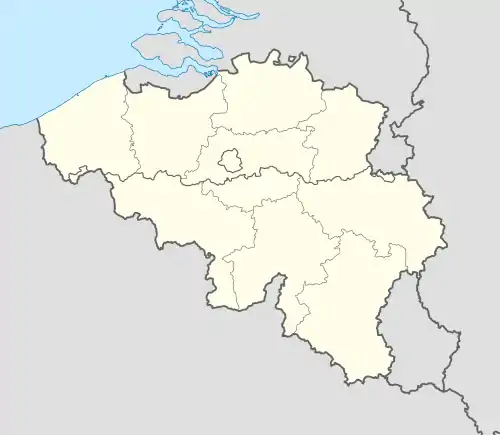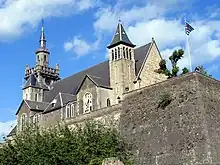Arlon
| |
|---|---|
City and municipality | |
 Arlon centre with bell tower of St. Martin's Church | |
 Flag  Coat of arms | |
Location of Arlon | |
 Arlon Location in Belgium
Location of Arlon in Luxembourg province  | |
| Coordinates: 49°41′N 05°49′E / 49.683°N 5.817°E | |
| Country | |
| Community | French Community |
| Region | Wallonia |
| Province | Luxembourg |
| Arrondissement | Arlon |
| Government | |
| • Mayor | Vincent Magnus (cdH, ARLON 2030) |
| • Governing party/ies | MR-ARLON 2030 |
| Area | |
| • Total | 119.06 km2 (45.97 sq mi) |
| Population (2022-01-01)[1] | |
| • Total | 30,818 |
| • Density | 260/km2 (670/sq mi) |
| Postal codes | 6700, 6704, 6706 |
| NIS code | 81001 |
| Area codes | 063 |
| Website | www.arlon.be (in French) |
Arlon (French pronunciation: [aʁlɔ̃] ⓘ; Luxembourgish: Arel [ˈaːʀəl] ⓘ; Dutch: Aarlen [ˈaːrlə(n)] ⓘ; German: Arel [ˈaːʁəl] ⓘ; Walloon: Årlon) is a city and municipality of Wallonia located in and capital of the province of Luxembourg in the Ardennes, Belgium. With a population of just over 28,000, it is the smallest provincial capital in Belgium. Arlon is also the capital of its cultural region: the Arelerland (Land of Arlon in Luxemburgish).
The municipality consists of the following sub-municipalities: Arlon, Autelbas, Bonnert, Guirsch, Heinsch, and Toernich. Other population centers include:
- Autelhaut
- Clairefontaine
- Fouches
- Frassem
- Freylange
- Hachy
- Heckbous
- Rosenberg
- Sampont
- Schoppach
- Sesselich
- Seymerich
- Stehnen
- Sterpenich
- Stockem
- Udange
- Viville
- Waltzing
- Weyler
- Wolberg
History
Roman Empire 57BCE–395
Western Roman Empire 395–480
Francia 481–843
Middle Francia 843–855
Kingdom of Lotharingia 855–900
Duchy of Lorraine 900–950
County of Arlon 950–1214
County of Luxembourg 1214–1353
Duchy of Luxembourg 1353–1795
French Republic 1795–1804
French Empire 1804–1815
Grand Duchy of Luxembourg 1815–1839
Kingdom of Belgium 1839–present
(Margraviate) County of Arlon | |||||||||
|---|---|---|---|---|---|---|---|---|---|
| 950–1221 | |||||||||
| Status | County | ||||||||
| Capital | Arel (Arlon) | ||||||||
| Government | Principality | ||||||||
| Historical era | Middle Ages | ||||||||
• Established | 950 | ||||||||
• Raised to margraviate | ca 1167 | ||||||||
• United with the County of Luxemburg | 1214 | ||||||||
• Annexed to the Duchy of Luxembourg | 1221 | ||||||||
| |||||||||
Roman and medieval times
Before the Roman conquests of Gaul, the territory of Arlon and a vast area to the southeast were settled by the Treveri, a Celtic tribe. The local population adapted relatively easily to Roman culture. The number and quality of sculpted stones and monuments that have been unearthed in the area demonstrate that the vicus of Orolaunum quickly became a commercial and administrative centre of Roman civilization. The Germanic invasions of the 3rd century destroyed most of these early advances, despite the defensive walls that had been built on the Knipchen hill to protect the vicus.
During most of the Middle Ages, the population still used the earlier buildings such as the thermae. In 1060, Waleran I of Limburg, Count of Arlon, built a castle on the Knipchen hill in the centre of the town.
A dynasty of counts of Arlon began with Waleran I, Duke of Limburg. On the death of Duke Waleran III in 1226, Arlon passed to his son from the second marriage, Henry V the Fair, Count of Luxembourg, and became part of the county of Luxembourg. Thus, in the Tournament of Chauvency, his son Henry the Lion bore the title of Marquis of Arlon.
In the 13th century, the only women's Cistercian abbey known to date was built in Clairefontaine.
15th century until the French Revolution
The Duchy of Luxembourg itself, of which Arlon was dependent, became part of the Burgundian Netherlands under Philip the Good in 1441. After Charles V's abdication of his empire to his son Philip II of Spain in 1556, a troubled period started for the whole region with continuous wars involving France, Spain and the Southern Netherlands. In 1558, nearly half of the city, including its castle, was destroyed by the French troops of Francis, Duke of Guise. In the 17th century, Capuchin friars built a convent on the ruins of the castle and the French strengthened the defensive walls according to Vauban's designs. An accidental fire destroyed a large part of the city again in 1785.

Modern times
On 9 June 1793 the French Revolutionary troops opposed the Austrians just outside Arlon. The French emerged victorious and took over the city from Austrian rule. They expelled the Capuchin friars and used their convent as a hospital.
In June 1815, after the defeat of Napoleon in the Battle of Waterloo, Arlon went back to government of the Grand Duchy. By the Treaty of London in 1839, the grand duchy became fully sovereign and in turn geographically larger western part of the duchy, i.e. the province de Luxembourg including Arlon city was given to newly created Kingdom of Belgium.
Arlon was one of the first victims of the German invasion in 1914 as 121 inhabitants were executed on 26 August, on the orders of Colonel Richard Karl von Tessmar.
Its territory was again among the first to be invaded at the onset of World War II. Allies moved into Belgium on 10 May 1940 and Arlon was defended by French troops, but they were not able to stop the German invasion.
Arlon today
Being situated very close to the border with the Grand Duchy of Luxembourg, Arlon has continued to expand with new residential areas and commercial development zones, and many people cross the border everyday to work in the Grand Duchy. All international express trains make a stop in Arlon, as it is the last station on the main Brussels—Luxembourg City railway line.[2]
Sights

- Arlon is best known for holding one of the richest archeological museums in Belgium. It houses numerous examples of Roman sculpture and Merovingian funerary art.
- A fragment of the Gallo-Roman defensive wall that was built in the 3rd century still stands in Arlon.
- The Gaspar Museum is dedicated to the art of Jean-Marie Gaspar and Charles Gaspar, and also holds a collection of regional art including the Fisenne altarpiece, an altarpiece from the 16th century originally located in the village Fisenne.
- Saint Donat's church now stands on the Knipchen hill, where Waleran I of Limburg once built his castle and the Capuchin friars built their convent.
- Arlon cemetery has the largest Jewish section of all Walloon cemeteries.
Local customs
- The carnival of Arlon takes place at mid-Lent. It includes the traditional handing of the city keys to the carnival prince and a colourful parade composed of various folk dance groups.
- The Maitrank (German for "drink of May") is the city's most popular refreshment. It is made of white wine in which a local flower, the Asperula odorata, has macerated. Some recipes also add cognac or substitute woodruff for the Asperula. The Maitrank festivities take place in the city every fourth Sunday of May.
Climate
| Climate data for Arlon(1991-2020) | |||||||||||||
|---|---|---|---|---|---|---|---|---|---|---|---|---|---|
| Month | Jan | Feb | Mar | Apr | May | Jun | Jul | Aug | Sep | Oct | Nov | Dec | Year |
| Mean daily maximum °C (°F) | 4.0 (39.2) |
5.3 (41.5) |
9.7 (49.5) |
14.1 (57.4) |
18.0 (64.4) |
21.2 (70.2) |
23.3 (73.9) |
22.9 (73.2) |
18.7 (65.7) |
13.4 (56.1) |
7.8 (46.0) |
4.6 (40.3) |
13.6 (56.5) |
| Daily mean °C (°F) | 1.4 (34.5) |
1.9 (35.4) |
5.2 (41.4) |
8.6 (47.5) |
12.6 (54.7) |
15.8 (60.4) |
17.8 (64.0) |
17.3 (63.1) |
13.5 (56.3) |
9.5 (49.1) |
5.1 (41.2) |
2.2 (36.0) |
9.2 (48.6) |
| Mean daily minimum °C (°F) | −1.3 (29.7) |
−1.5 (29.3) |
0.7 (33.3) |
3.1 (37.6) |
7.1 (44.8) |
10.4 (50.7) |
12.2 (54.0) |
11.8 (53.2) |
8.4 (47.1) |
5.6 (42.1) |
2.4 (36.3) |
−0.3 (31.5) |
4.9 (40.8) |
| Average precipitation mm (inches) | 121.4 (4.78) |
93.5 (3.68) |
80.3 (3.16) |
63.1 (2.48) |
75.7 (2.98) |
79.4 (3.13) |
79.4 (3.13) |
82.8 (3.26) |
78.2 (3.08) |
100.5 (3.96) |
103.9 (4.09) |
146.9 (5.78) |
1,105.1 (43.51) |
| Average precipitation days (≥ 1.0 mm) | 14.3 | 12.6 | 11.9 | 9.7 | 10.9 | 10.2 | 10.8 | 10.5 | 10.0 | 12.2 | 14.2 | 15.8 | 143.1 |
| Mean monthly sunshine hours | 49 | 73 | 132 | 196 | 208 | 222 | 234 | 214 | 162 | 103 | 49 | 41 | 1,683 |
| Mean daily sunshine hours | 1.6 | 2.6 | 4.3 | 6.2 | 6.7 | 7.4 | 7.6 | 6.9 | 5.4 | 3.3 | 1.6 | 1.3 | 4.6 |
| Source: KMI[3] | |||||||||||||
Demography
The town of Arlon is the most populated of the municipalities in the province of Luxembourg, ahead of Marche-en-Famenne and Aubange. On the other hand, it is the least populated of the country's ten provinces. On 31 December 2019, the city of Arlon had a total population of 30,047 inhabitants.
Politics
List of mayors :
- Pierre Hollenfeltz
- 1880–1901 : Joseph Netzer
- 1901–1921 : Numa Ensch-Tesch
- 1921–1949 : Paul Reuter
- 1949–1958 : Jules Massonnet
- 1958–1976 : Charles Simon
- 1977–1988 : Jean Goffinet
- 1989–1992 : Guy Larcier
- 1993–1994 : Jean Goffinet
- 1995–2006 : Guy Larcier
- 2007–2012 : Raymond Biren
- 2013–... : Vincent Magnus
People born in Arlon
- Johann Kaspar Basselet von La Rosée, Bavarian general (1710–1795)
- Godefroid Kurth, historian (1847–1916)
- Jean-Marie Gaspar, sculptor (1861–1931)
- Benoît Lamy, film director (1945–2008)
- Ingrid Lempereur, swimmer (1969)
- Jeroen van Busleyden, humanist (1470–1517)
- Anthony Moris, Luxembourgish footballer (1990)
- Timothy Castagne, Belgian footballer (1995)
International relations
Twin towns — sister cities
Arlon is twinned with:
 Saint-Dié-des-Vosges, France since 1962
Saint-Dié-des-Vosges, France since 1962 Diekirch, Luxemburg
Diekirch, Luxemburg Bitburg, Rhineland-Palatinate, Germany since 1965
Bitburg, Rhineland-Palatinate, Germany since 1965 Sulphur, Louisiana, United States
Sulphur, Louisiana, United States Hayange, France
Hayange, France Alba, Italy since 1 March 2004
Alba, Italy since 1 March 2004 Market Drayton, England, UK
Market Drayton, England, UK
See also
References
- ↑ "Population par lieu de résidence, nationalité (Belge/non-Belge), état civil, âge et sexe".
- ↑ Larousse, Éditions. "Arlon - LAROUSSE". www.larousse.fr (in French). Retrieved 2023-06-06.
- ↑ "Klimaatstatistieken van de Belgische gemeenten Aarlen (nis 81001)" (PDF). meteo.be (in Dutch). KMI. pp. 2, 5. Retrieved 2024-01-06.
External links
- Official site
- Alternative to official site (in French)
- Official Maitrank web site (in French)
- Official Saint-Martin parish website of Arlon city (in French)
